


Benjamin Partleton (1839-1910)
PART II
This page is continued from PART I of the story of Benjamin Partleton (1839-1910).
Benjamin has lived his early childhood in the vicinity of The Strand, Drury Lane, circled in blue in the map below. But in 1847, a big change is about to happen as the family pulls up stumps and heads off south of the river to Lambeth, circled in yellow.
Benjamin's family almost certainly crossed the River Thames via Westminster Bridge during their house move, past the old Houses of Parliament, as it is the only bridge on the route at that date. Their destination, Lambeth, is where most of the Partleton family have been living since the 1820s:

Ben's first address in Lambeth is on the High Street, and it is there that 8-year-old Benjamin gets a new baby brother:
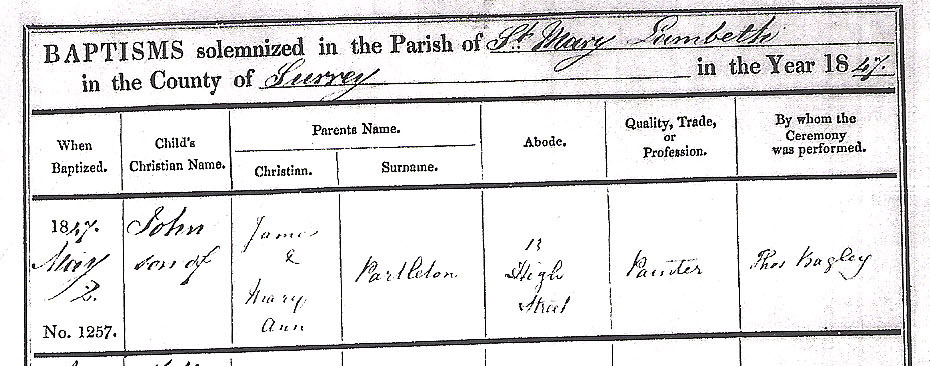
We see from the above that Ben's address is 13 High Street, at the point of the yellow arrow below:
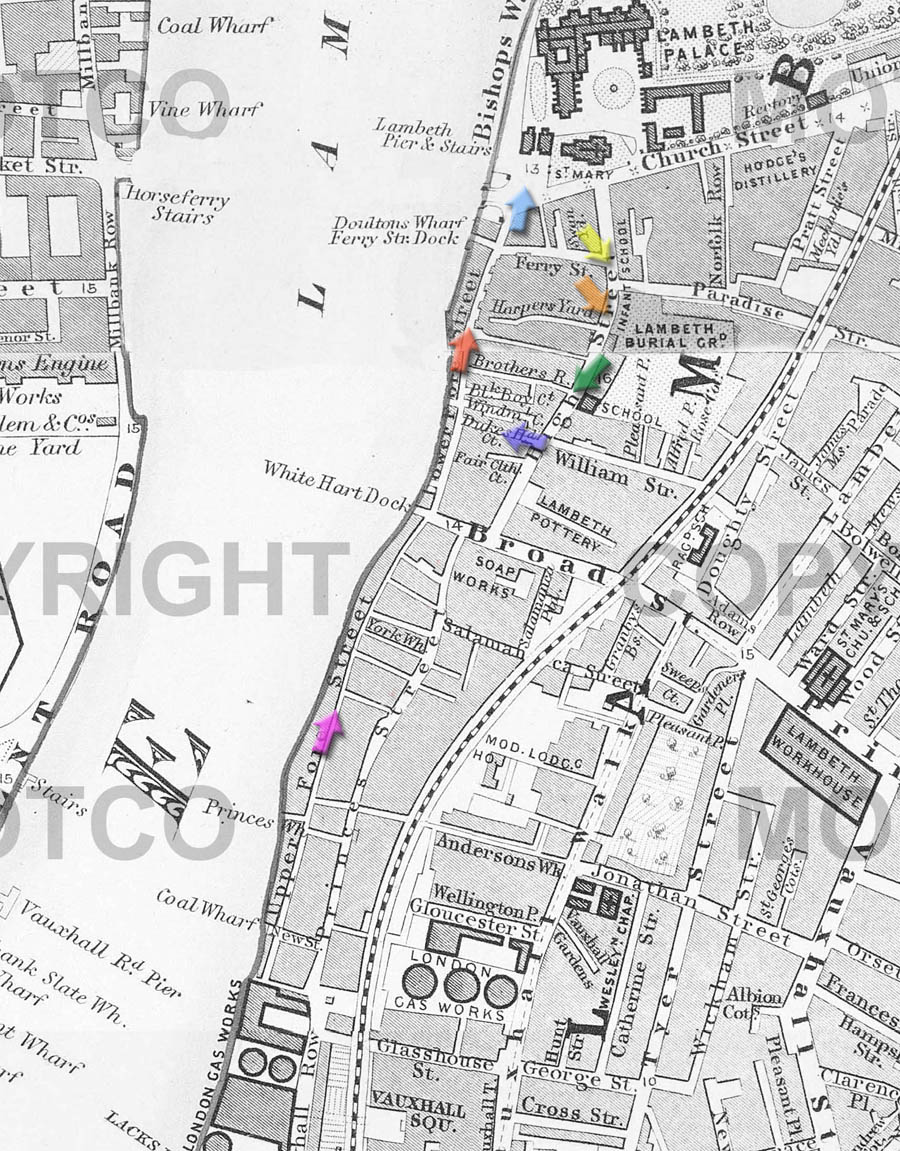
Number 13 is at the north end of the High Street, on the east side of the road, near the junction with Paradise Street, and may very well be upstairs in one of the buildings in the picture below, seen from the yellow arrow, the railings of Lambeth Burial Ground and the turning to Paradise Street facing us on the right. Unfortunately there were changes on this part of the High Street during the mid-1800s, and consequently I can't be sure which house is which. There were some buildings demolished to expand the graveyard and it might have been one of those:

Here's the gates of the Burial Ground, a little further south, seen from the orange arrow. These would be an extremely familiar sight to Benjamin as they are so close to his home; it's soon to be the resting place of his little sister Sarah:

Let's have another look at the baptism entry for John in the Parish Register:

Benjamin was very likely present at the christening of his brother, which was held at the church of St Mary-at-Lambeth. For what it's worth, here's a watercolour painting of the actual font of St Mary-at-Lambeth Church, in which baby John was baptised:
 Left: A rather unimpressive picture of a font
Left: A rather unimpressive picture of a font
I understand that the font is still in the building, though the church of St Mary-at-Lambeth [near the pale blue arrow below] was deconsecrated in 1972, and descended towards a state of dereliction; demolition plans were drawn up in 1976, but the building was rescued by finding a new use for it in 1978 when it became the Museum of Garden History, as it remains today.

We have dozens of pictures of the old church on this website, but here's something a bit different; printed on the closed edge of a book, a nice view of the church (on the right), from viewpoint of the pale blue arrow in the map above:

The brick building in the centre of this print is Lambeth Palace, the London residence of no less than the Archbishop of Canterbury [as it is still today], just 100 yards from Benjamin's slum home.
Below we have a cracking good scurrillous joke set outside the palace, of about the same period as the picture above. You can even see the same tree in the background:

We see the Archbishop and a famous local character, Lambeth Nanny, who sold fruit from a basket. They're standing outside the main entrance to Lambeth Palace:
Archbishop: "Take off your bonnet good woman, and I'll give you my blessing!"
Lambeth Nanny: "Ah! If your grace's blessing won't go thru bonnet and all, I would not give you one of my apples for it!"
Back to our Benjamin. His dad James, a house painter, is still obviously strapped for cash because the next house he chooses to rent is in one of the poorest streets in Lambeth... Crookets Alley, aka Coquets Alley, aka Cockills Alley, aka Duke's Head Court which is how we see it named at the point of the dark blue arrow in the map below:

Here's a picture of Duke's Head Court, from the viewpoint of the dark blue arrow:
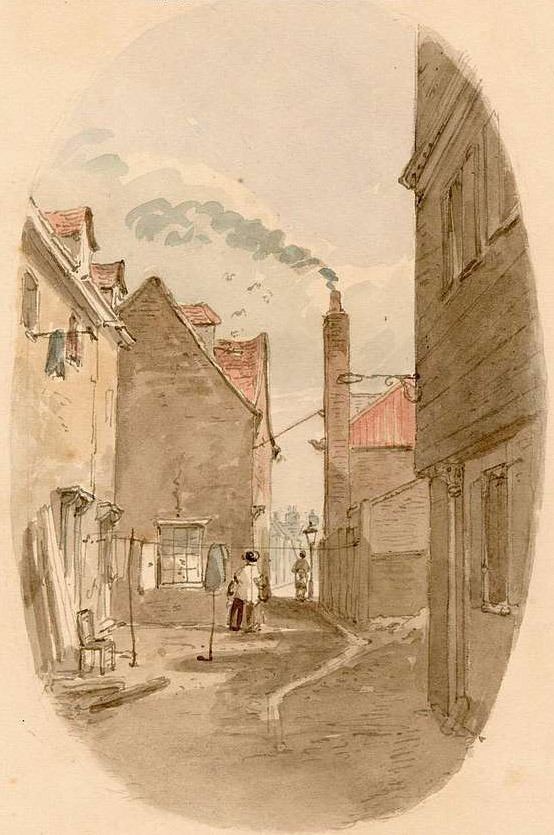
This watercolour painting is from the book Surrey Illustrations by the artist J Findlay, and I think we need to treat it with caution as the book is clearly a travelogue which naturally makes its subjects look quaint. This was painted c1850, the exact time period in which Benjamin lived here. The people in the picture really could be could be Benjamin's family.

We have lots of photographs of the immediate area around Ben's house which are shown in the web pages for Ben's dad James, his twin brother Charles and his little sister Sarah, and I don't like to re-use them. However, we need to balance Mr Findlay's lovely watercolour painting with a photograph of the reality of living in an alley off Lower Fore Street.
Here we see Lower Fore Street looking north, approximately from the red arrow. Ah yes; not so quaint after all:

What would be the effect of the poverty which is so manifest in Benjamin's life situation, living here on Lower Fore Street? If you think about it, it's obvious. There would be many, many times when there was no money whatever in the home. Ben would have gone to bed hungry. Sometimes in the winter the house would be unheated for want of coal. Freezing. Inadequate bedding to keep you warm at night, dressed in rags during the day. Unwashed.
Lambeth Archive has the next picture identified as Lower Fore Street, but I'm not convinced. The street surface and the buildings in the distance aren't right. I think we are in one of the many alleys running east from either Lower or Upper Fore Street looking towards the High Street or Princes Street. Either way, welcome to Benjamin's world:
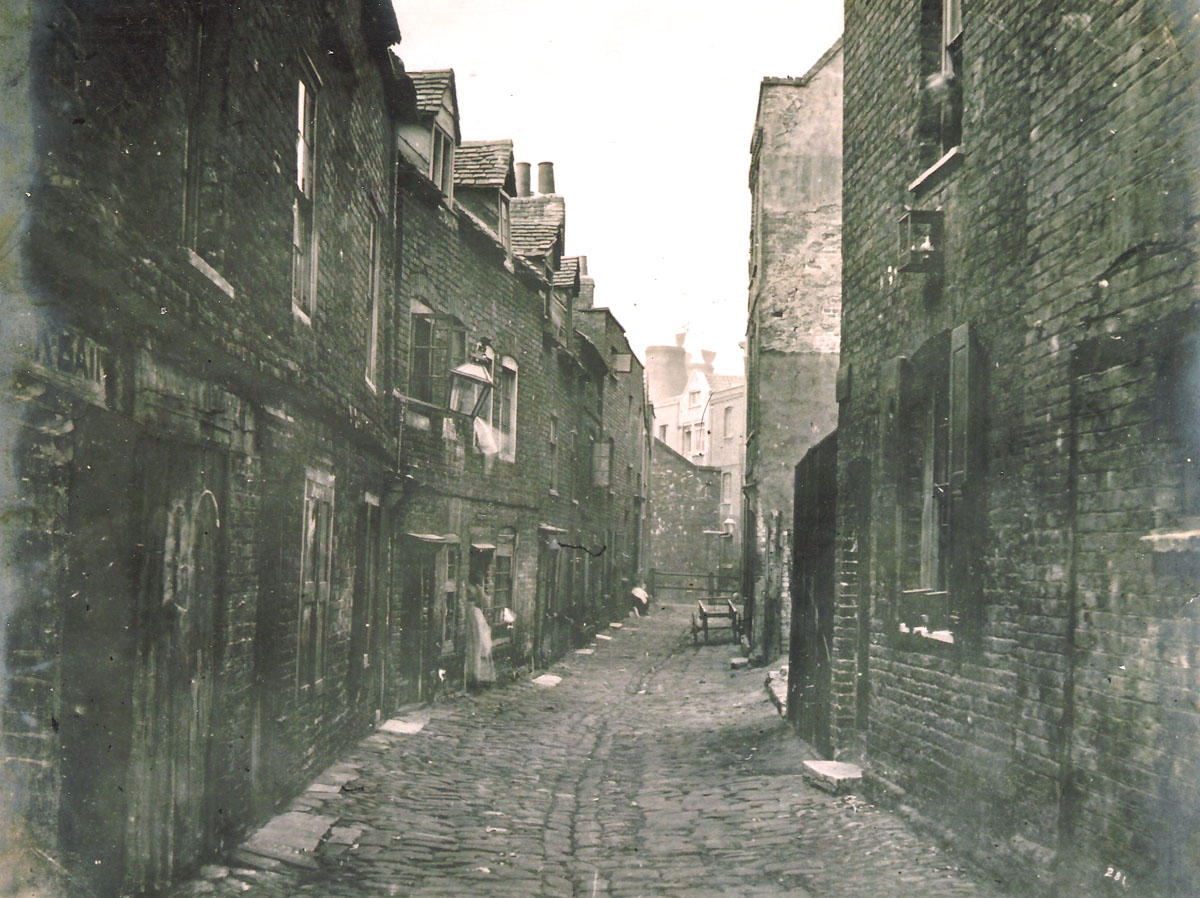
If you'd like to try to imagine Mary Ann Garrad's situation, I've zoomed in on the lady in the photo whom I think is a fair illustration:
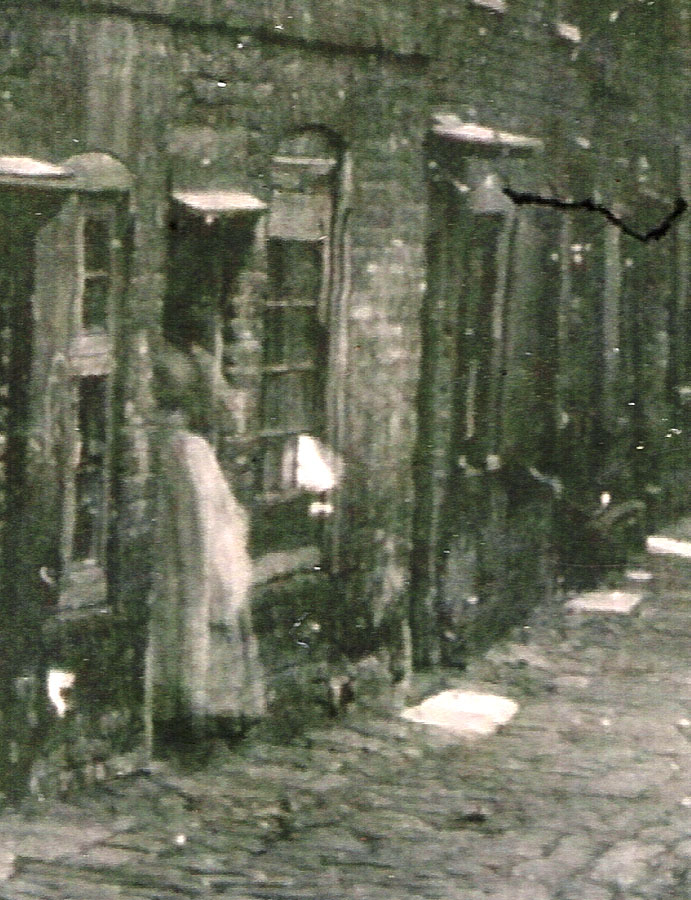
Surprisingly there is a pub on Lower Fore Street, on the east side. It's The Duke's Head, which is where Benjamin's alley gets its name.

If we go to the other end of Duke's Head Court, walk a short distance down the High Street and look south, we get the following view, from the point of view of the dark green arrow:
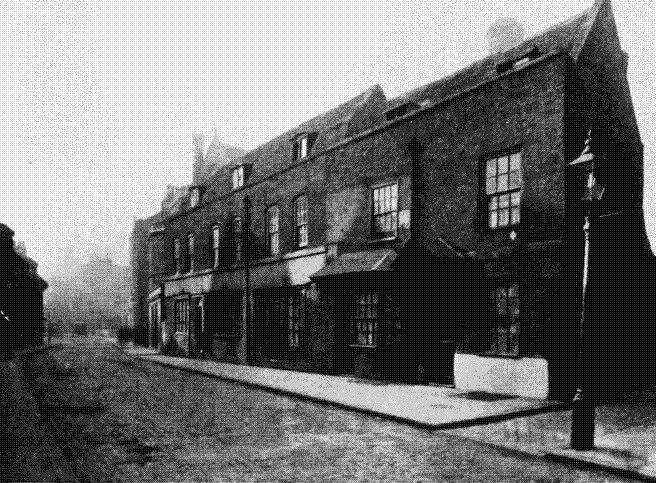
The smoggy, grainy picture we see above was taken in 1908, a full 60 years after Benjamin lived at Duke's Head Court. It's from a book called Survey of London: Volume 23. What we see are numbers 49 to 53 High Street. The second alley on the right in the distance is the entrance to Duke's Head Court.
Benjamin in 1849 is now 10 years old and at times is possibly drinking water straight from the river Thames; a very dangerous necessity because there is no fresh water supply in the street. This sounds quite unbelievable at such a late date, but don't take my word for it - here's the report of Doctor John Snow into the 1849 Lambeth Cholera outbreak:
![]()
This is the era of the famous Great Stink when the Thames was so overloaded with sewage from London's thronging millions that it became almost intolerable to breathe the air. In the Houses of Parliament on the other side of the river, just a mile away, they hung curtains soaked in vinegar in an attempt to keep the smell out.
Add to this that the whole area of Lambeth, which was built on marshes, and especially Fore Street and its neighbourhood, became flooded with the spring tides every year. Below we see the residents of nearby Princes Square building an improvised barricade to try to keep the sewage-laden flood water out... It didn't work:

The flooding did not just occur at spring tides: this is The Times of December 1845:
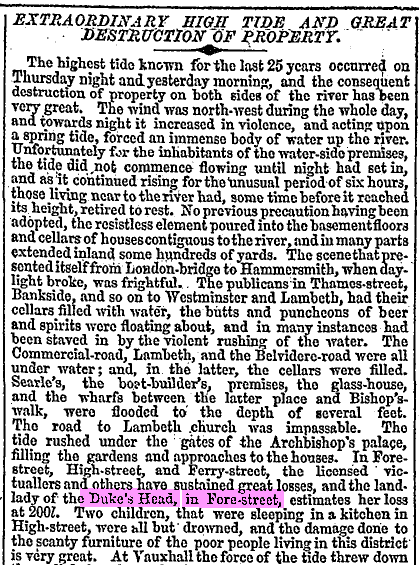
This frequent flooding did not end until the building of the Albert Embankment in 1869. Benjamin's house would certainly have been two feet deep in stinking water at least once a year.
So, in July 1849, almost inevitably, Benjamin lost another sister. This time it was little Sarah Partleton, aged just 4, who became one of the first victims of the 1849 Cholera outbreak, dying after 11 hours of agony:

A few days later, 24 July 1849, a Lambeth ratepayer wrote to The Times with his own theory about what caused the rapidly spreading Cholera outbreak. The Victorians didn't know it was in the water. They actually thought it was in the air... and sewage was not the only thing that was making a stink in Lambeth:
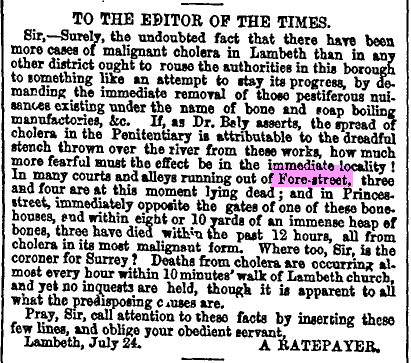
Here's one of those bone-works which Mr Ratepayer was complaining about, picture courtesy of Lambeth Archives. This smelly edifice is the premises of Mr Alfred Hunt in Upper Fore Street. The year; 1860:
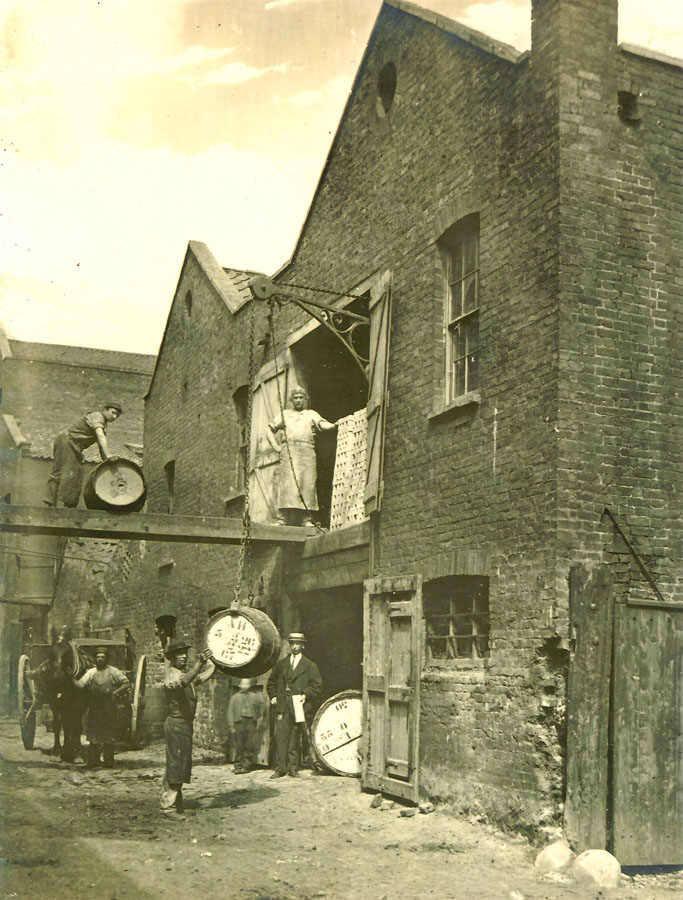
.jpg)
Boiling bones is not something you do just for fun. Presumably there must have been some useful product emerging from this process, which was big business in Lambeth... Barrels are required, as we see, stamped with Alfred Hunt's initials, presumably to hold the end product... Glue? Fertiliser? The surprising answer, among other things, is soap. The bones were split lengthways, boiled up, and the liquefied rendered fat [which is what I think the barrels hold] was sold on for soap or candle production.
Alfred Hunt had more than one factory in Lambeth; there was another on the High Street, whose activities one author of the time found curious enough to mention in his book:

The above clip is from Curiousities of London by John Timbs, published in 1855.

These beautiful photographs of roads which Benjamin would have seen first-hand as a teenager were taken by the master photographer William Strudwick [who sadly, at the end of his life, was admitted as a pauper in Croydon Workhouse in May 1910 and died there soon after]. The pictures are of Upper Fore Street but I can't pinpoint the exact point of view. Alfred Hunt's bone business is at 'Old Court', Upper Fore Street, but unfortunately Old Court is not specified in any of my old maps.
A huge soap works can be seen on Broad Street which probably buys bone fat from Alfred Hunt.
Below we see a more distant view of Alfred Hunt's premises, in the background behind these characters... we are looking north along Upper Fore Street, roughly from the purple arrow:

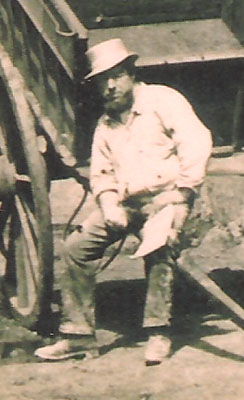
Since we are now in the early 1860s, it's a good time to have a review of Benjamin's family. Here's the 1861 census:

Benjamin is now 21 and has a job as a carter.
"What's a carter?", I hear you ask, and it's a reasonable question. Logically it's a person who moves stuff around in a cart. There are carts evident in practically every photo of Lambeth, like the one of Upper Fore Street above; but that's a horse-drawn cart. Benjamin certainly doesn't have a horse. Does he operate a hand cart, or does he work for someone and lead a horse around? We'll probably never know the answer to that one, though frankly, it's not the most important bit of family history, so I'll let it go.
The family have moved a few yards from Duke's Head Court, and we have an actual picture of their new abode, 79 Broad Street, at the point of the yellow arrow below:

We'll need to clear the map of arrows and start afresh. The map below shows us the photographer's position when he stood in Broad Street in 1860, from the blue arrow, the location of Ben's house picked out in yellow. The smelly soap works are immediately at the photographer's left, out of picture:
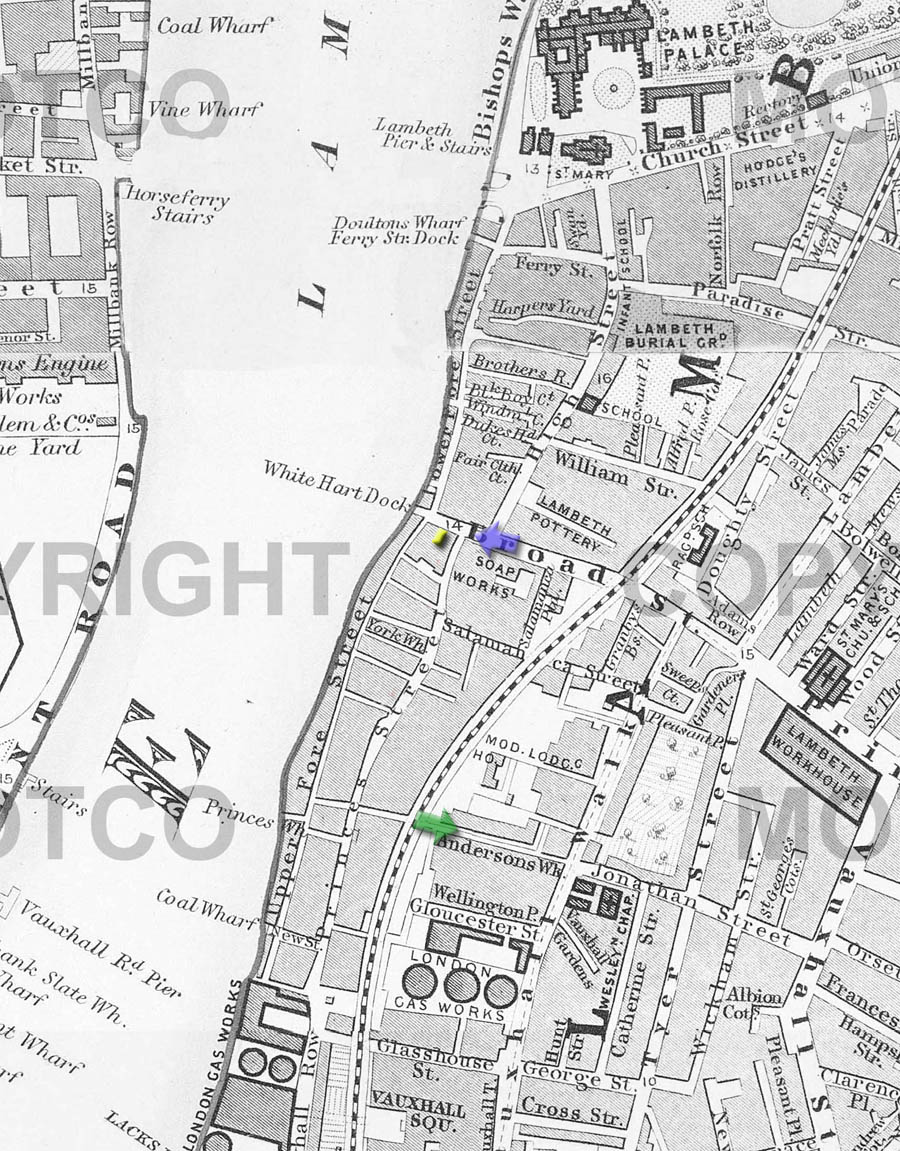
Three years later, Benjamin is still at Broad Street. We know this because we have his original marriage certificate of 19 June 1864, complete with Victorian duty stamp, given to him on his wedding day, handed down through the family, and scanned for us by Ceridwen Davies whose husband Richard Tanguy is a descendant of Benjamin!

The bride is Jane Elizabeth Clark, aged 24. We see on the cert that her dad's job had been a lamplighter.
 Left: this is not Jane Clark's dad. But you realised that.
Left: this is not Jane Clark's dad. But you realised that.
Jane's mum had died before she was 11, and by the time of her marriage, her dad is dead as well. Such is life in Lambeth.
One year later, almost to the day, 18 June 1865, Benjamin and Jane's first child, Jane Elizabeth Partleton is born.
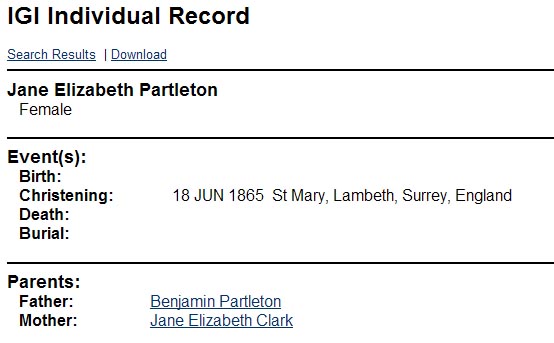
The next child is Sarah, born in the July quarter of 1866.
Then came Benjamin, who was christened on 23 May 1869 [Which happens to be my birthday. Well, not the 1869 bit, obviously]. But sadly little baby Benjamin died in July 1870.
So we come to another census. Time flies, doesn't it? We have reached 1871, and we find Benjamin and Jane in their own home, Anderson's Walk, where they are to reside for at least 30 years.

As usual, the census is ram-jam full of interesting stuff. Benjamin, now 32, has his sister-in-law Sarah Crawley [nee Clark] staying at the house, with her baby daughter Mary Crawley. Also a visitor is Henry Crawley.
But where's Benjamin's wife Jane?... though her sister Mary is staying at her house with a new-born baby, she's staying a half-mile down the road, in Vauxhall, with her other sister, Mary Hills [nee Clark]:
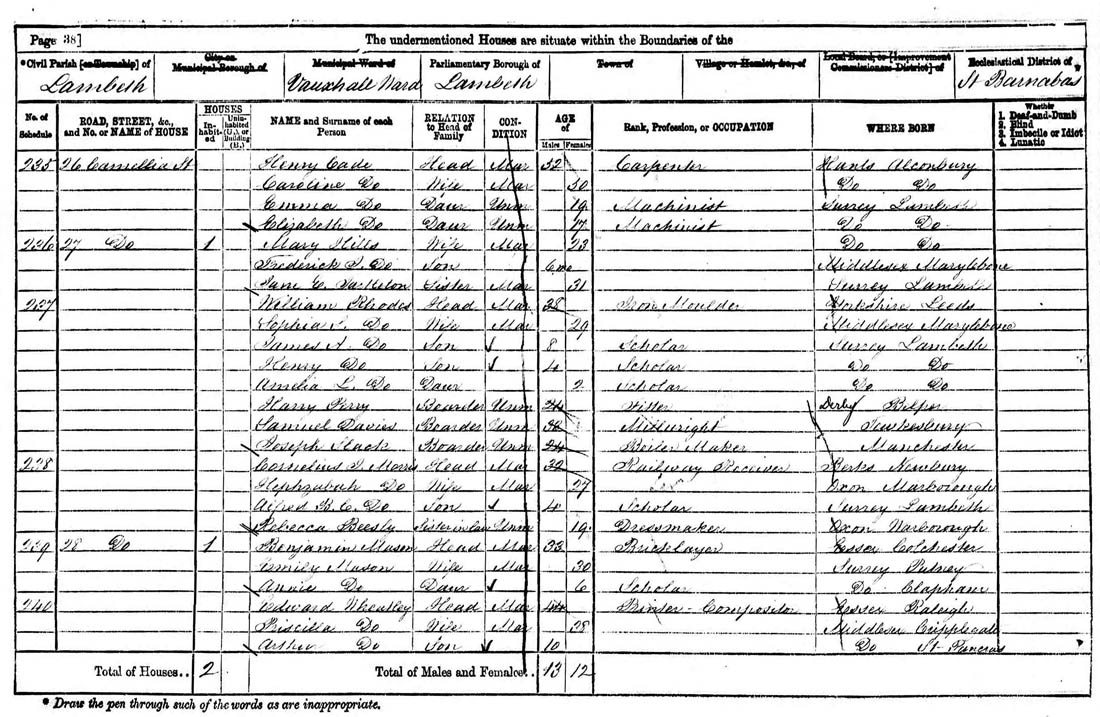
Let's get back to Benjamin. His address of Anderson's Walk is indicated by the green arrow in the map below.

Do we have a picture of Anderson's Walk? It seems a bit unlikely, because, as the name suggests - it's a just a footpath, not even a road. But surprisingly, in 1932, artist Joan Bloxam took a stroll along Anderson's Walk with her sketchbook and preserved an image of it, four years before it was demolished, especially for us to understand where Benjamin lived. Step into Benjamin's shoes and have a walk down his road:
From the shadows of the fences we can tell that we must be looking east with the railway arches behind us, from the viewpoint of the green arrow. It's all very cutesy-poo. Ben and Jane are in one of these houses with their two little girls. Their domicile is much nicer than the places where Benjamin grew up; the houses even have little front gardens and picket fences. Maybe even a flushing toilet.
Let's move on with the family. Jane Elizabeth is pregnant during the census because in October 1871 she gives birth to another girl, Mary Louisa:

In 1873, Benjamin's dad James and mum Mary Ann both die within a few weeks of each other in Lambeth.
And in October 1874 Benjamin gets another daughter, Florence Emma.
Next we have the birth certificate of Benjamin's fourth daughter Ada Amelia Partleton, 28 May 1877, again a Victorian copy, obtained in 1891 when she was 14 for some purpose unknown, perhaps as proof of identity for a job, passed to us by Richard Tanguy and Ceridwen Davies, complete with ancient sellotape repairs:

Ada Amelia Partleton lived long, long into the 20th century, passing away in the January quarter of 1975, aged 97. She's by far the longest-lived Partleton to date. She never married... am I alone in thinking this state seems often to be associated with longevity?
Benjamin's last child, Catherine Maud, was christened on 18 October 1880.
So we move on to the 1881 census:

Some of Ben's kids have very Victorian-sounding jobs; Envelope-folder; Bottle-labeller.
We note that Benjamin himself is occupied, as he has been for at least 10 years, as a Bill Poster. Bills are everywhere in Victorian Lambeth, to a degree which modern eyes would find objectionable. They probably weren't all that popular with the Victorians either. This photograph is of Lambeth Road at its junction with Stangate, north of St Mary-at-Lambeth church, the Houses of Parliament in the background, and a splatter of posters in the foreground:

To help visualise Benjamin's job, here's a picture of a couple of Victorian bill posters in London, this photograph taken in 1878 by photographer John Thompson. Step into Ben's shoes and his gluey hands:
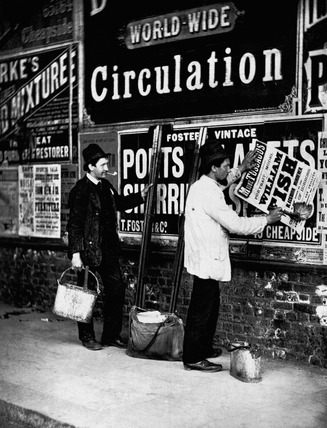
In the January quarter of 1890, Benjamin's wife Jane Elizabeth Clark died, aged 49. We don't know the cause yet, and if we proceed to the next census, 1891, we find Benjamin a widower, at home with five of his six daughters:

There's also a mystery visitor in the house who may be Mary Crawley, Benjamin's niece who was in the house as a baby in 1871, but her given age doesn't quite fit. Mary's 'relationship' is poorly written but it may say 'cousin' [to the girls, not to Benjamin]. Can anyone read it?
Now it seems a good time to introduce a rarity... an actual Victorian photograph of a Partleton, no less than our Benjamin:
 -
-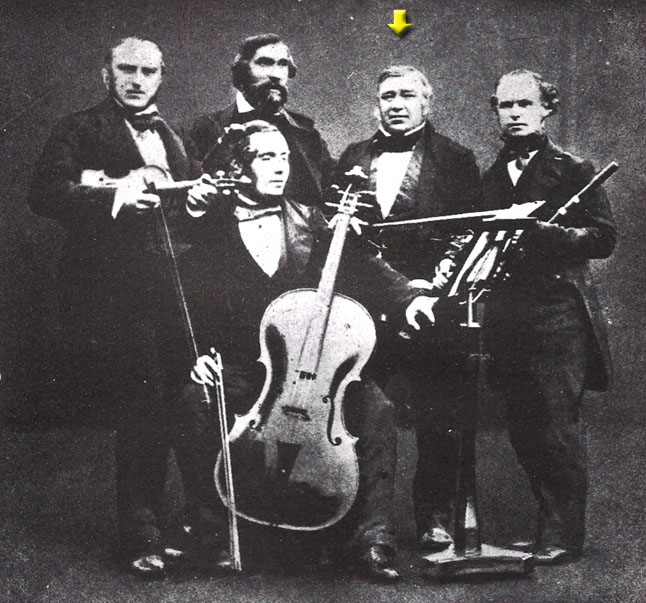
Benjamin is the one on the left. If we compare him with another rare Victorian photograph, on the right, we can see a strong family resemblance with his uncle, George Partleton (1814-1866), picked out with the yellow in the photograph on the right about 30 years earlier.
But when was that picture of Benjamin taken? Let's have a look at the whole picture:
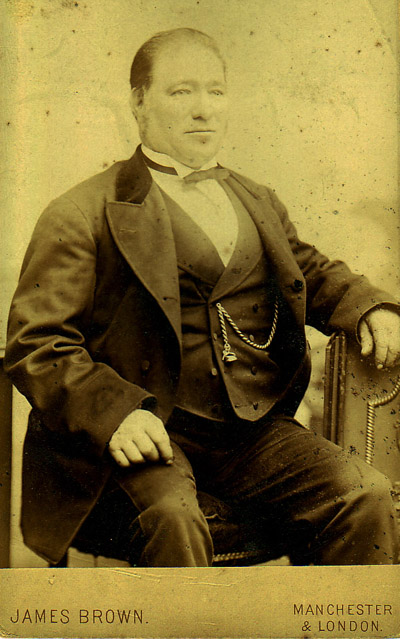
As was customary at the time, the photographer took care to advertise his services on the image. In this case it was James Brown of Camberwell Road in south London.
James Brown operated his studios at 132 Camberwell Road (1885-1886) and then 148 Camberwell Road (1886-1888): narrow dates, so Benjamin is around 50 in the photo, which looks about right.
Let's step into Benjamin's shoes, put on our Sunday best clothes, and take a trip to James Brown's studio on Camberwell Road, which we see below, to get our picture taken:
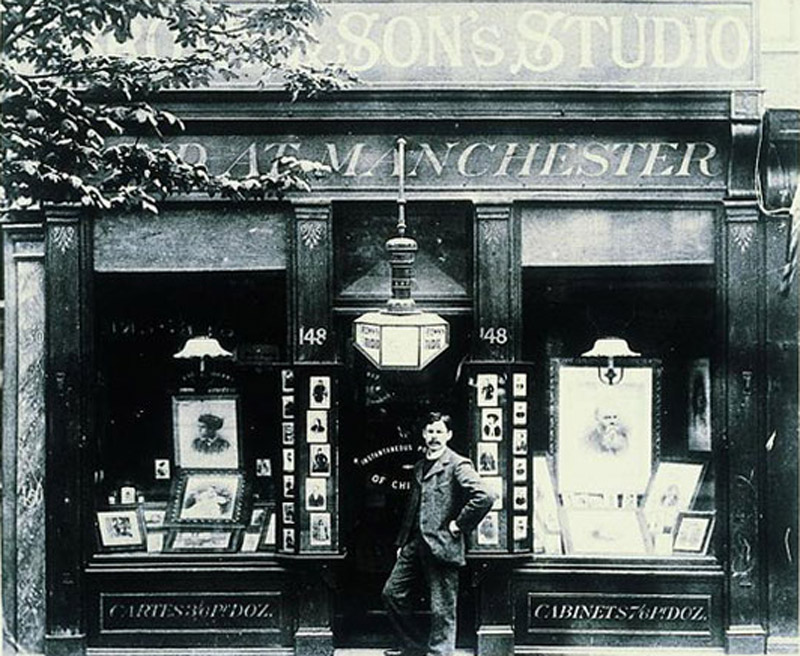
The man in the picture is William Brown - James Brown's son, who took over the studio in 1888.
A few years after his photo was taken, in the 1890s, we can introduce some more information about Benjamin's home at Anderson's Walk...
At this time, the Victorian philanthropist Charles Booth took a walk past the house where Benjamin is living with his daughters, for his Poverty Survey of London, and here's what he had to say about it:
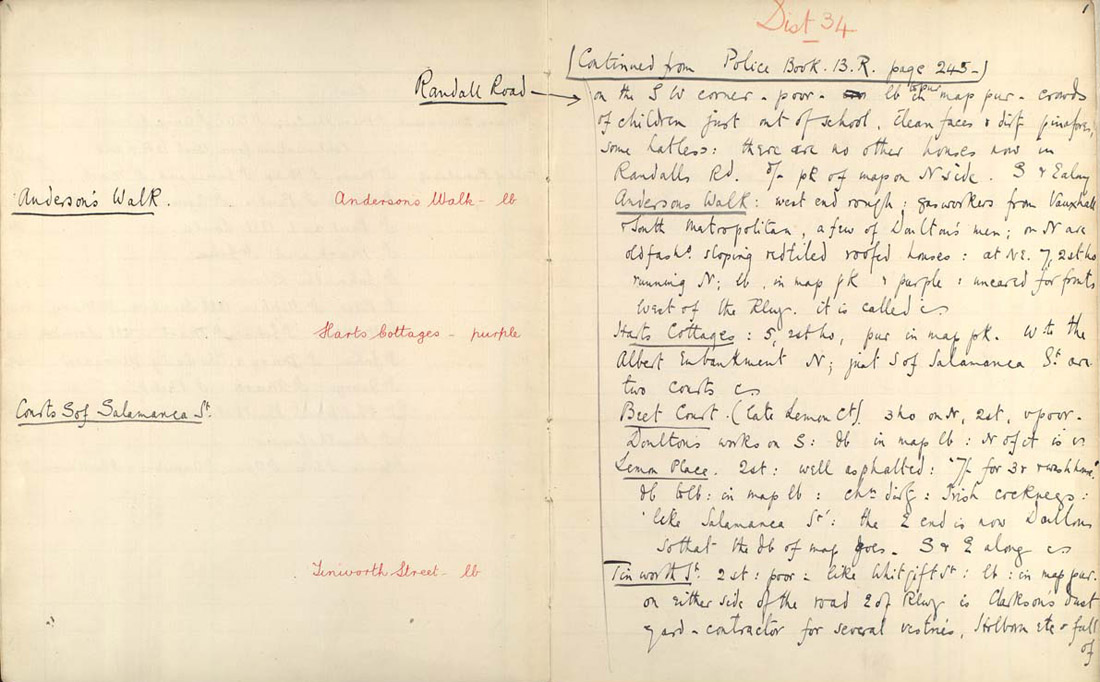
Deciphering Charles' handwriting we get a nice first-hand insight into the condition of Anderson's Walk:
'West end rough: Gas workers from Vauxhall & South Metropolitan, a few of Doulton's men [ie pottery workers] : On the North are old-fashioned red-tiled roofed houses : at NE 7[north east?] , 2 storey houses running North : lb [light blue, meaning 'poor'] in map [illegible] , pk [pink, meaning 'fairly comfortable'] purple[meaning 'Mixed. Some comfortable others poor':] uncared-for fronts west of the railway, it is called ~ Harts Cottages.'

In general Charles Booth thought the the street was moderately, but not extremely, poor. Anderson's Walk is cut in two by the railway, which flies over the whole neighbourhood on arches. Did Benjamin live in the "rough" west end of the street, or the nicer end, east of the arches, which we see below?
All in all, Benjamin seems to have come up the world from his childhood of abject poverty.
But this does not seem to protect him or his family from a circumstance familiar to most Victorian working-class families: early death. In October 1895, Benjamin's daughter Catherine Maud Partleton died aged just 14, cause unknown at present.
And what of Benjamin's twin brother Charles? All of this time, he's been living close by, less than ten minutes' walk. And we realise that the families are close because on 19 December 1896, Benjamin's daughter Mary Louisa Partleton marries Charles' stepson Henry Charles Russell Arnold. Mary and Henry are cousins by marriage but they're not blood relatives:
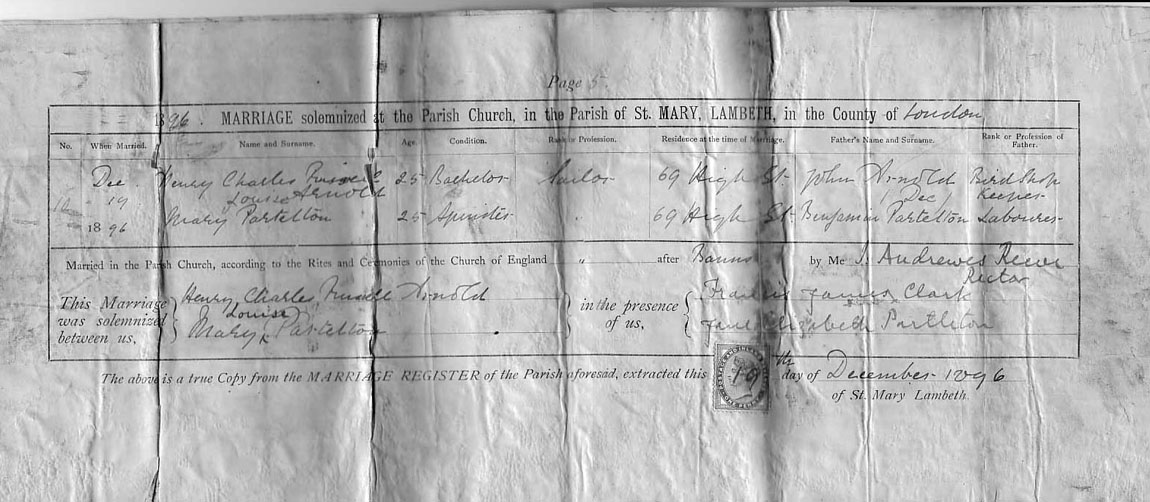
Another signal that all these families are close and their lives entwined is the witness Francis James Clark... he's Benjamin's brother-in-law, the brother of Jane Elizabeth Clark. Francis lives just around the corner in Vauxhall Walk and his daughter works as an envelope folder. Sounds familiar?
We move on again to our last census, 1901:

Benjamin is still at 12 Anderson's Walk. Having been there probably since the late 1860s, he's lived at the same address through five different decades!
He still has four of his daughters at home, including Mary whose husband Henry Charles Russell Arnold is a Chief Petty Officer in the Royal Navy [he later fought at the Battle of Jutland] which explains his absence from home. Mary's daughter Mary Beatrice Elizabeth Arnold, aka "Madge", aged 3 in the census, was born in Queensferry, Linlithgow, Scotland - near to the Rosyth Naval Base at Edinburgh, in 1897. Madge grew up to become an actress, playing minor roles on stage and screen, and is believed to have died in the USA in 1979. [Thanks to one of our correspondents, Dr Richard Hardie, who is descended from Mary Partleton, for that information].
Here's Madge's birth certificate:
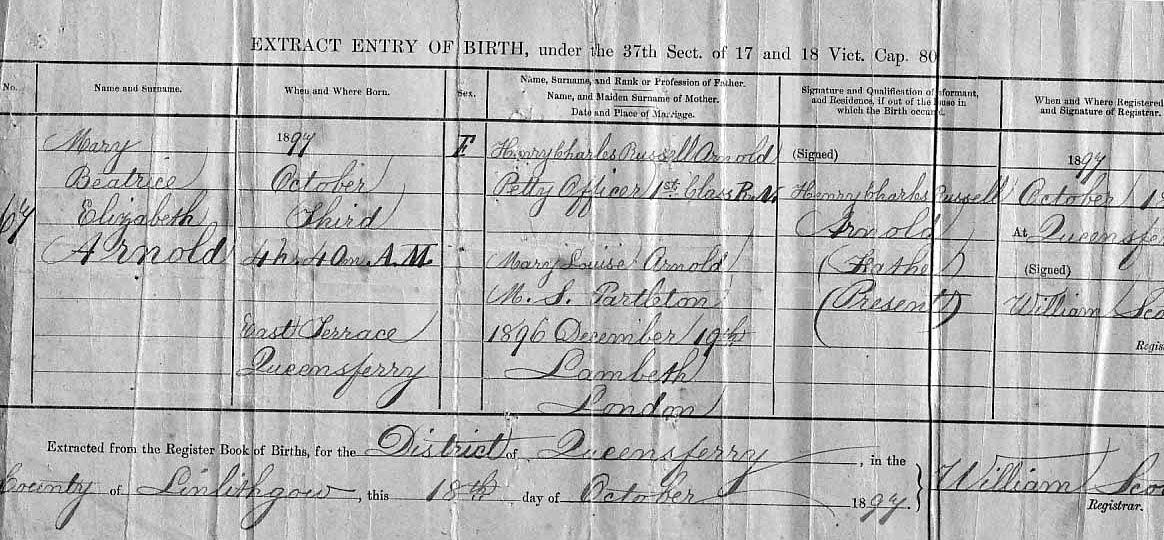
Benjamin's granddaughter Madge was born at East Terrace, High Street, Queensferry which turns out to be a very interesting location. It's at the point of the blue arrow on Queensferry High Street in the modern map below, right between the two famous bridges across the Firth of Forth:
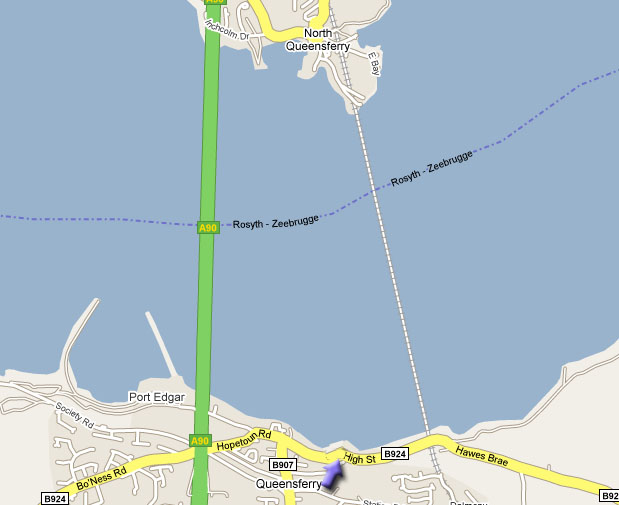

Here's the view of the stunning, iconic rail bridge of 1890, from Madge's birthplace, viewpoint of the blue arrow:

I drove right past it, and close to Madge's house, just yesterday, as my son is at university in Edinburgh. Here's the view from the north side. It always catches the eye:
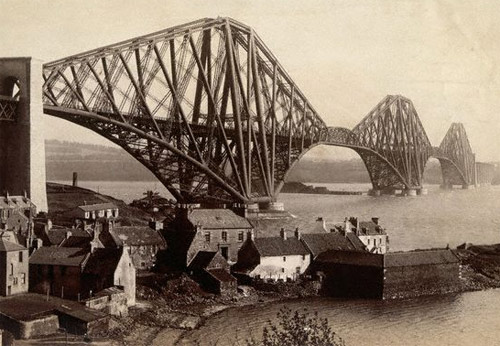
And here's what we see from East Terrace today; the road suspension bridge was built in 1965:

Let's get back to Benjamin and that census of 1901:

Of great interest in this census is that Benjamin at age 62 has adopted a little girl, Mary Elizabeth Wannell, who is just 9 years old, presumably being looked after by her big Partleton sisters. Fully formalised adoption processes weren't developed until the 1920s in Britain, and it would be very interesting to uncover just how this adoption came about. Presumably Mary is an orphan.
Moving on, in July 1904, Benjamin's fourth daughter, Florence, married Walter Coombes in Lambeth.
And in August 1907, tragedy struck as Benjamin's daughter Mary Louisa Partleton died of cardiac failure aged just 36, leaving little Madge aged 10 and her two little sisters Winifred, 5 and Maud, 1, without a mother. Here's the death certificate, courtesy of Terry Partleton:

Mary Louisa's husband Henry Arnold remarried in 1914, to Lily Worsfold.

Back to 1907, October: Benjamin's second daughter, Sarah Ann Partleton married Harry Ellis in Croydon District, probably Mitcham.
A few months earlier, in July 1907, Mary Louisa Partleton was buried in the graveyard of Christ Church Mitcham. I mention this because we are nearing the end of Benjamin's life and it seems he has moved out to the suburbs, to Mitcham. For those of you who are not familiar with South London, here's where Mitcham is:
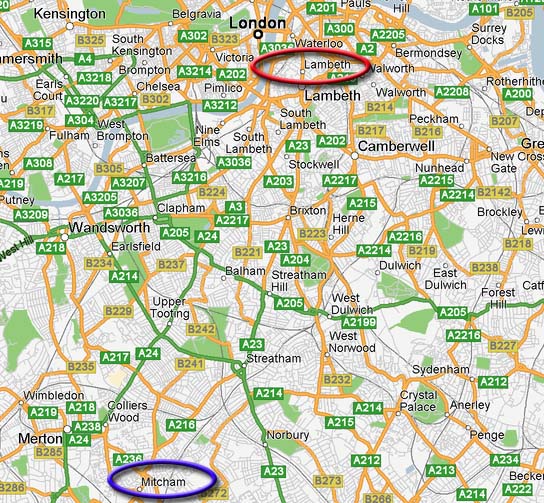
Benjamin Partleton, born 1839 in Houghton Street, Strand, passed away in July 1910 aged 71 and was buried in Christ Church graveyard, Mitcham, next to his daughter Mary Louisa who had predeceased him three years earlier.
In 2007 Terry Partleton paid a visit to Christ Church and obtained the burial plot number of Benjamin's resting place. It's one of these in the satellite photo below:


However, the gravestone - if there still is one - proved elusive and it seems we'll need another visit to track this down.
If you enjoyed reading this page, you are invited to 'Like' us on Facebook. Or click on the Twitter button and follow us, and we'll let you know whenever a new page is added to the Partleton Tree:
Do YOU know any more to add to this web page?... or would you like to discuss any of the history... or if you have any observations or comments... all information is always welcome so why not send us an email to partleton@yahoo.co.uk
Click here to return to the Partleton Tree 'In Their Shoes' Page.
